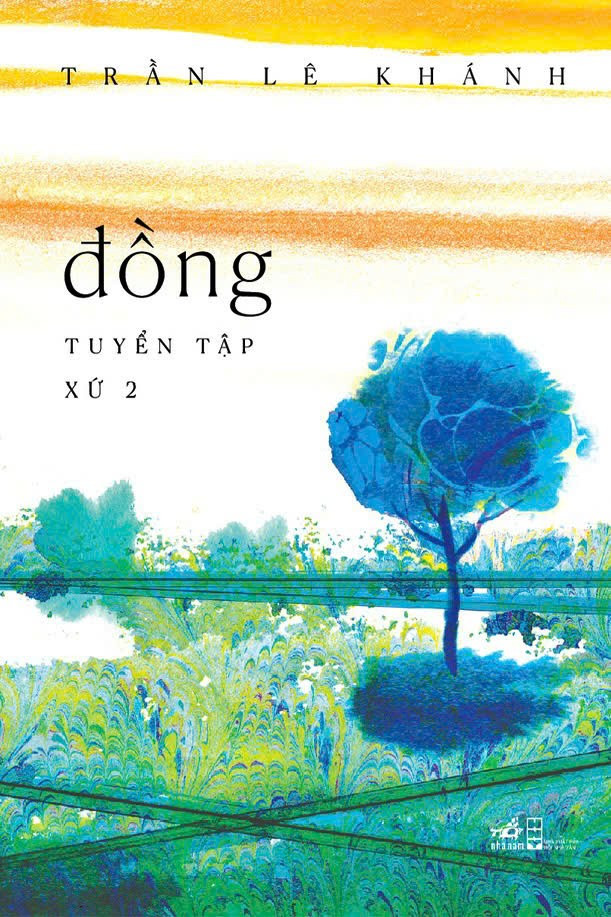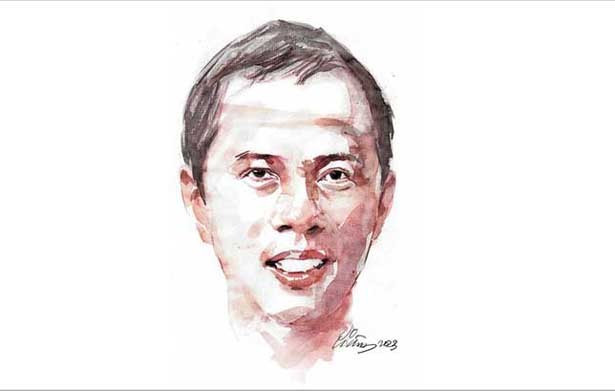
Reading Tran Le Khanh's poetry, I see a journey from the dust of the world to the main hall, from the status of a small ant to the enlightenment of the nature of "I" and "Buddha". This journey is full of torment but also imbued with compassion, raising the question of where humans will go between the vortex of suffering and the desire for liberation.
Impermanence, reincarnation, suffering and the desire for liberation
One of the prominent themes in Tran Le Khanh's poetry is the sense of impermanence - the awareness that everything changes and human life is but a moment. This is clearly expressed through the meditative image: "the universe is an eyelash / each blink of an eye takes a day away". The universe suddenly becomes fragile, can disappear in a moment. Time is no longer measured in days and months but in the blink of an eye, but contains the fading of all things. That is the spirit of impermanence: everything changes, nothing is eternal.
The sense of impermanence also reflects on human life. "Oh, you who are quickly bored and thirsty/ life is a time when familiar things gradually dry up". This verse sounds so heartbreaking. "Soon bored and thirsty" evokes the desire-filled, ever-changing nature of human beings. But more deeply, it is a reminder of the loss that everyone must experience: the longer we live, the more we see "familiar things gradually dry up". Impermanence is not just an abstract rule, but a bitter life experience.

If impermanence is the foundation, then reincarnation and suffering are the other two pillars. Tran Le Khanh has depicted the mystical rebirth of the soul and the erosion of the body: "The soul is just three years old/ but the body has rolled around for nine lives". A fundamental paradox of human life: the youthfulness of the soul contrasts with the aging body. This is the concept of the five aggregates in Buddhism, that the body and mind are not identical and not eternal. In that vein, he wrote: " Through many stormy lives/ the wind touches the face and still feels unfamiliar". The "unfamiliarity" here is both a feeling of alienation from the flow of life and an unknowability in the cycle of reincarnation. Through countless lives, people are still lost, unable to find their "true face". The verse contains sadness and is also a subtle expression of egolessness: there is no fixed self that exists through countless lives.
Suffering is also recognized in the existential realm, through the fragility of worldly life: "The earthly realm is so thin, my dear/ Heavenly realm is not enough to bite your lips forever". The earthly realm is "so thin", easily broken. Happiness in heaven, seemingly eternal, is also not long-lasting because "not enough to bite your lips forever". The verse both speaks of the suffering of human life and reminds us of the finiteness even of higher realms. Here, Tran Le Khanh approaches the concept of "suffering" in a unique way: suffering is not only deprivation, but also the inability to maintain happiness.
In addition, the small but haunting details also depict suffering: "The fire ant is lost in the night/ the tiny soul stands up to look at the sky". The ant, a symbol of the small, nameless, lost in the night. However, that "tiny soul" still "stands up to look at the sky". That is the desire to escape from a lowly status, the desire for liberation, not by great strength, but by a fragile awakening.
Thus, Tran Le Khanh's poetry depicts a circle of life: from impermanence to reincarnation, from suffering to the desire for liberation. He does not recreate dry teachings, but makes them come alive with everyday images: an old chrysanthemum, the wind blowing across the face, a fire ant in the night... That is the way to make Buddhist philosophy become closer, touching the consciousness of readers.
Buddhist symbols and messages about life and aesthetics
Another highlight in Tran Le Khanh's poetry is the presence of images of pagodas, monks and meditative moments. These elements are both religious backgrounds and become aesthetic and philosophical symbols.
The temple appears as a sacred space, where everything bears the mark of spirituality: "The temple is sacred, even the blade of grass is sacred/ the light only shines on sentient beings" . The temple is sacred not only because of the Buddha statue or the sutras, but even the "blade of grass" is imbued with spirituality. Perhaps this represents the spirit of all sentient beings: all things contain Buddha nature, all have the ability to evoke enlightenment. However, that light "only shines on sentient beings", reminding that it is humans, in their finiteness, who are the place where suffering converges and where the light is most needed.
The pagoda in Tran Le Khanh's poem is not a grandiose construction, but often very simple: "The pagoda was built roughly/ with a few aimless steps on the grass." A "rough pagoda" is created with just a few steps on the grass. This image shows the simplicity of the Buddhist lifestyle and also implies that pagodas are first and foremost spiritual spaces, not dependent on material things, but arising from sincerity.

The image of the monk also appears, associated with the world of dust and the light of compassion: "The monk walks among the dust of the world/ the golden sunlight lies on the feet on the road". "Dust of the world" is a symbol of the mundane world , but "the golden sunlight lies on the feet" has the meaning of purification and support. The verse shows the presence of the monk as an act of transformation: entering the world but still shining with serenity, bringing faith and protection.
Another evocative image: "the monk/ steps into the main hall/ his shadow/ moves aside". The shadow - a symbol of the ego - is pushed aside. When entering the main hall, the monk seems to blend into the sacred space, leaving behind his ego. This is an artistic expression for the state of awakening, when a person becomes pure and not dominated by the ego.
Tran Le Khanh depicts meditative moments with a metaphor: "the distance/ between me and Buddha/ is equal to the size of his empty mind". This distance is not measured by space but by "empty mind" - a core concept in Buddhism. This means that the boundary between mortals and enlightenment lies only in the emptiness of the mind. The verse is simple yet profound: only when the mind is completely free of delusions, the difference between humans and Buddha will disappear.
Through the above images, it can be seen that Tran Le Khanh has built a Buddhist space that is both concrete ( pagoda, monk, main hall ...) and symbolic ( empty mind, shadow, ants... ). This combination helps his poetry to be close to the spiritual life of Vietnamese people, while also suggesting profound philosophical layers.
In terms of aesthetics, Tran Le Khanh's poetry combines Zen intuition and modernity of language. Zen intuition is expressed in the way he captures moments, for example "the universe is an eyelash / each blink of an eye takes a day" - concise but containing profound philosophy. Modern language is expressed in the technique of breaking traditional structures, bringing everyday images into Buddhist thoughts, making the poem both strange and familiar.
It can be said that Tran Le Khanh's poetry has the appearance of both Zen poetry and modern philosophical poetry. This interweaving creates a unique poetic voice: not fussy about form, but always suggesting deep thoughts. Reading his poetry, people find the beauty of language and a suggestion to live peacefully in a turbulent life.
Through simple but haunting verses, Tran Le Khanh has opened a journey of contemplation about Buddhism in a very unique way. He does not preach doctrine but uses poetic images to touch the consciousness of readers. The journey "from the dust to the main hall" in his poems is the journey that each of us can find in life: from suffering, impermanence to find peace and liberation in our own hearts.
Source: https://nhandan.vn/hanh-trinh-phat-tinh-trong-tho-tran-le-khanh-post908463.html




![[Photo] General Secretary To Lam receives Assistant to the President of Russia, Chairman of the Federal Maritime Council of Russia Nicolai Patrushev](https://vphoto.vietnam.vn/thumb/1200x675/vietnam/resource/IMAGE/2025/9/16/813bd944b92d4b14b04b6f9e2ef4109b)
![[Photo] Prime Minister Pham Minh Chinh receives Minister of Foreign Affairs and Cooperation of Timor-Leste](https://vphoto.vietnam.vn/thumb/1200x675/vietnam/resource/IMAGE/2025/9/16/b0e99fd9a05846e4b6948c785d51d51f)

![[Photo] General Secretary To Lam attends the National Conference to disseminate and implement 4 Resolutions of the Politburo](https://vphoto.vietnam.vn/thumb/1200x675/vietnam/resource/IMAGE/2025/9/16/70c6a8ceb60a4f72a0cacf436c1a6b54)
![[Photo] National conference to disseminate and implement 4 Resolutions of the Politburo](https://vphoto.vietnam.vn/thumb/1200x675/vietnam/resource/IMAGE/2025/9/16/5996b8d8466e41558c7abaa7a749f0e6)














![[Photo] Prime Minister Pham Minh Chinh receives Minister of Foreign Affairs and Cooperation of Timor-Leste](https://vphoto.vietnam.vn/thumb/402x226/vietnam/resource/IMAGE/2025/9/16/b0e99fd9a05846e4b6948c785d51d51f)




































































Comment (0)